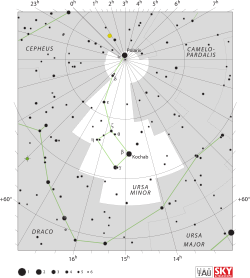Ursa Minor
| Constellation | |

|
|
| Abbreviation | UMi |
|---|---|
| Genitive | Ursae Minoris |
| Pronunciation |
/ˌɜːrsə ˈmaɪnər/, genitive /ˌɜːrsiː mᵻˈnɒrᵻs/ |
| Symbolism | the Little Bear |
| Right ascension | 08h 41.4m to 22h 54.0m |
| Declination | 65.40° to 90° |
| Family | Ursa Major |
| Quadrant | NQ3 |
| Area | 256 sq. deg. (56th) |
| Main stars | 7 |
|
Bayer/Flamsteed stars |
23 |
| Stars with planets | 4 |
| Stars brighter than 3.00m | 3 |
| Stars within 10.00 pc (32.62 ly) | 0 |
| Brightest star | Polaris (1.97m) |
| Nearest star |
UU UMi (42.60 ly, 13.06 pc) |
| Messier objects | 0 |
| Meteor showers | Ursids |
| Bordering constellations |
Draco Camelopardalis Cepheus |
|
Visible at latitudes between +90° and −10°. Best visible at 21:00 (9 p.m.) during the month of June. |
|
Ursa Minor (Latin: "Lesser Bear", contrasting with Ursa Major), also known as the Little Bear, is a constellation in the Northern Sky. Like the Great Bear, the tail of the Little Bear may also be seen as the handle of a ladle, hence the North American name, Little Dipper: seven stars with four in its bowl like its partner the Big Dipper. It was one of the 48 constellations listed by the 2nd-century astronomer Ptolemy, and remains one of the 88 modern constellations. Ursa Minor has traditionally been important for navigation, particularly by mariners, because of Polaris being the North Star.
Polaris, the brightest star in the constellation, is a yellow-white supergiant and the brightest Cepheid variable star in the night sky, ranging from an apparent magnitude of 1.97 to 2.00. Beta Ursae Minoris, also known as Kochab, is an aging star that has swollen and cooled to become an orange giant with an apparent magnitude of 2.08, only slightly fainter than Polaris. Kochab and magnitude 3 Gamma Ursae Minoris have been called the "guardians of the pole star". Planets have been detected orbiting four of the stars, including Kochab. The constellation also contains an isolated neutron star—Calvera—and H1504+65, the hottest white dwarf yet discovered, with a surface temperature of 200,000 K.
In the Babylonian star catalogues, Ursa Minor was known as MAR.GID.DA.AN.NA, the Wagon of Heaven, Damkianna. It appeared on a pair of tablets containing canonical star lists that were compiled around 1000 BC, the MUL.APIN, and was one of the "Stars of Enlil"—that is, the northern sky. The possible origin of its name was its appearing to rotate like a wheel around the north celestial pole.
...
Wikipedia
